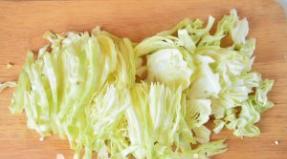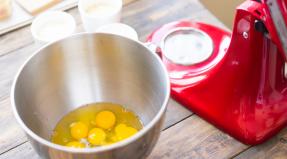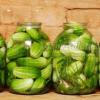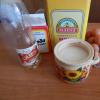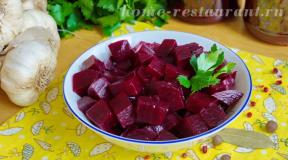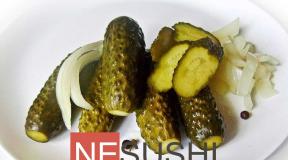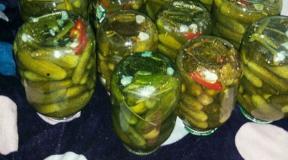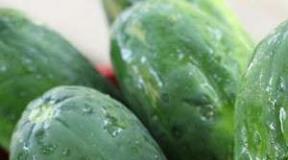A bag of tea for a girl. Interesting ways to use a used tea bag
A tea bag is a closed paper package, inside of which is shredded tea. A small bag of filter paper contains a single batch of tea, designed for one time. The appearance of this package may be completely different. In Europe, rectangular paper bags have long been common. They can be either single-chamber or two-chamber. The latter have one common side, connecting both volumes into one.
How was the tea bag born
The New York tea importer, Thomas Sullivan, invented the tea bag in 1908 by chance when he sent tea leaves to his customers in small silk bags to reduce their own financial costs. Those, in turn, having plunged the entire handbag into boiling water and immediately receiving a fragrant hot drink, they thought it was so intended. They liked this quick and easy brewing procedure, and they began to demand such bags instead of dried leaves.
How did the bags of gauze
On what only you will not go for the sake of important clients! However, Thomas understood that silk as a packaging material is too expensive. After a bit of thought, he decides that a tea bag made from gauze will not in the least spoil the taste of the aromatic beverage. And after a while he sets up the production of tea blend packaging in gauze bags, and grinds the remnants of dried leaves into a very fine powder and puts it on sale to people of a lower class. As the saying goes, the sheep are safe and the wolves are fed. Today, such a product is on sale called low-grade tea, and true gourmets will not consume such a drink.
The appearance of two-chamber bags

And only 10 years later, a tea bag was made in specialized factories, and already in 1929, a young engineer Adolf Rambold invented a small package for tea leaves, something similar to modern packaging. But the worst is the beginning, with each decade the forms and the material of the bag itself changed. Gauze, for example, was replaced very quickly, because it gave the drink an unpleasant taste. It was replaced by a special filter paper. And in the late 50s, a bag was created consisting of two chambers and locked with metal brackets. Paper material in such a product missed more water, and tea was brewed much faster.
Types of tea bags
1. Pyramid. Such packings are closed with a metal bracket, because glue can be released from the sealed pouch when heated, which will adversely affect the taste of tea.
2. Tightened in knots. Some manufacturers do not roll up the product, but simply tie it up with a string.
3. Closed thermo. Paper for tea bags is used only filter, containing thermoplastic fiber.
4. With an elongated thread. This type of packaging is considered the most common, and today it is used by millions of tea lovers. It is very convenient because at any moment, pulling the end of the thread, pull it out of the cup with the present drink.
5. Flat bags of a round form. Very popular in the UK. They are put on the bottom of the glass and poured boiling water. The amount of liquid depends on the size of the package. Also, these tea samples are easily brewed in kettles or coffee pots.
6. Empty bags. They are designed for convenient brewing tea. It is necessary to fill the necessary amount of tea leaves into an empty container, drag it with a string and lower it into the cup. You can buy your favorite tea in granules and enjoy its taste without discomfort.
Tea bag box

Modern technology has replaced the random invention of handmade. Filling tea bags now takes place on engineered machines specifically designed to limit the brew’s aerial effect on the wrapper with the greatest efficiency and prepare tea bags for international distribution. Today, an aromatic blend folded into a bag is sold in countless ways. Many companies now offer this magic drink in attractive packaging that can be found in abundance on supermarket shelves.
It is used for quick brewing tea with boiling water or hot water.
Construction and types[ | ]
It is a closed bag of filter paper, usually containing a single dose of tea for a single brew. The bag is usually closed with a metal bracket, because the glue would have a negative effect on the taste of tea. Some manufacturers do not close the bag, but simply tie it with a thread. Sometimes there are bags, closed by thermal method, for this the inner surface of the filter paper contains a thermoplastic fiber. Most tea bags have a thread, for which the bag can be easily pulled out of the finished tea.
The shape of the bag may be different. In Europe, rectangular sachets are common, which can be single-chamber or two-chamber (in the second case, the sachet consists of two rectangular sachets with one common side and has a larger internal volume). Recently, the production of tea in pyramid bags has been expanding under different brands - advertising claims that due to the larger volume, tea brews better in them; for the first time bags of this form were patented and appeared on the market in 1996. In the UK, flat round sacks without a cord are popular, which fit on the bottom of the cup. In addition to sachets designed for brewing one cup of tea, larger ones are also available, for several portions of water, for brewing in a kettle or electric coffee maker. Finally, tea bags are available. without tea, of various sizes, for two or three tablespoons of dry brewing - they allow you to brew any tea (it is simply poured into a bag, which is then dug over with thread) and are intended simply to enhance the convenience of brewing and facilitate the subsequent cleaning of brewing accessories.
The most common composition of the filter paper tea bags: natural wood fiber (65-75%), thermoplastic fiber (15-23%), abaca fiber (10%). This filter paper is highly permeable to water, is chemically neutral, does not affect the taste of tea, does not contain water-soluble components, does not dissolve in water itself, and does not emit anything in it. Recently, some manufacturers began to produce tea bags from a fine-mesh plastic mesh. Mesh pores are significantly larger than filter paper; it does not filter out fine dust, therefore it is suitable only for relatively coarsely chopped raw materials.
Some brands of packaged tea are available in double packaging: each filter bag is placed in a separate sealed paper envelope or a sealed, sealed envelope of foiled plastic. Such packing preserves the flavoring of tea better and protects it from absorbing extraneous odors for a long time, but it significantly increases the price.
Story [ | ]
It is believed that the predecessor of the tea bag was invented by merchant Thomas Sullivan in 1904, and quite by accident. Traditionally, tea was sold in large cans, but Sullivan decided that it would be more profitable to use small packaging, and used silk bags as a container. Customers, New York restaurateurs, found that tea in a new package is convenient to brew right in the bag. After a short time, this brewing method spread, silk was replaced with cheaper gauze, and the weight of tea was reduced to one portion. Packaged tea was widely used at the front during the First World War. However, Sullivan cannot be considered the discoverer of the very method of brewing tea in a bag of filter material. This method was known before, and it is hardly possible to name the name of the one who first thought it up. In any case, in the famous culinary book of Elena Molokhovets of the 1901 edition, the following method of brewing tea per family is recommended in recipe No. 3495:
Who has a large family, or is going to many guests, or a meeting of students, etc., there it is necessary to do so: instead of a teapot, have a small, purely preserved samovar, boil it, cover it with a lid. And as soon as the water stops boiling with the key, then pull the tea tied into a neat puddle up to half of the samovar, and throw a long thin ribbon attached to it over the samovar so that you can easily take out the puddle.
E. Molokhovets. "A gift to young housewives or a means to reduce costs in the household", edition 22. St. Petersburg, 1901
Modern tea bag was invented by an engineer at Teekanne (Dresden) . Tea bag appeared on the market in 1929. Adolf Rumbold is also the inventor of several tea packaging machines. In 1929, the Pompadour packaging machine was invented, which produced 35 sachets per minute, then Reliance (80 sachets), in 1949 the Constanta packaging machine (160 pcs.) Appeared. Too expensive silk was quickly excluded from the production of tea bags. The main packaging material for the first bags was gauze, a little later - a special paper made from Manila fibers, but it soon gave way to a more perfect one. At the end of 1950, a two-chamber tea bag patented by Teekanne, which was covered with metal straps, appeared. Thus, more water began to flow into the paper, the tea began to be brewed faster and more fully saturated with aroma.
Since the late 1970s, tea bags have practically supplanted previously pressed pressed and tiled tea (produced in the form of tablets or tiles pressed from tea powder and dust). One of the advantages of the bags was that the bag filters out particularly fine dust, and the tea turns out to be transparent, while brewing the tea tablets gave the tea an unpleasant, dull hue.
Quality tea bags[ | ]
The quality of teas sold in bags is quite diverse. Some manufacturers produce high quality and expensive leafy teas in packaged form. From such bags it turns out a very high-quality drink, which is almost or not at all inferior to that obtained by ordinary tea leaves. However, such packaged tea is expensive and occurs infrequently.
Typically, for the production of packaged tea, small-leaf tea or the so-called “leaf of category D” is used (from English dust, dust is a term that, along with others, leaf, broken, etc., describes the size of the tea leaf, not its quality), for which use a crumb or cutting of tea leaves. Unscrupulous manufacturers often fill the drawbacks of the aroma and taste of raw materials with flavors and flavors, as in the production of leaf tea.
Special plates for tea bags
Spread[ | ]
Despite the noted shortcomings, packaged tea is widely distributed in the world and its share in the total tea market is increasing. In Europe, the share of packaged tea is about 77%, and in England, known for its rich tea traditions, in 2007 up to 90% -96% of consumption falls on packaged tea. Bags firmly occupied a niche in inexpensive catering establishments and have become practically the standard for office tea drinking in Europe and America. Their consumption is also increasing in families.
In Russia, packaged tea has traditionally been unpopular, it has been used, for the most part, in situations where it was not possible to brew ordinary tea normally (on the road, in the office), and also served in catering establishments. At the beginning of the XXI century, the share of packaged tea in the Russian market did not exceed 9%. But in the future, the situation changed dramatically, and in the first quarter of 2015, packaged tea overtook the usual one. At the same time, however, there is an atypical trend: contrary to the notion that sachets are primarily consumed in large, industrialized cities with a high rate of life, in Russia the share of their consumption increases in small cities, while in Moscow, on the contrary, the share ordinary loose tea.
Gallery [ | ]
see also [ | ]
Notes [ | ]
- Glenda Cooper. Change brewing for reshaped tea market // The Independent, 24 February 1996 (English)
- Teekanne official website (him). [ ] ((subst: not AI))
- teatips.ru: brewing tea. tea service (general comments) ((subst: not AI))
- Identification and falsification of tea (Neopr.) . Znajtovar.ru.
- 100 years tea bag Archived October 21, 2007.
- The history of the tea bag Archived June 15, 2012.
- The Bags in the UK / UK Tea & Infusions Association (Eng.)
Construction and types
It is a closed bag of filter paper, usually containing a single dose of tea for a single brew. The shape of the bag may be different. In Europe, rectangular sachets are common, which can be single-chamber or two-chamber (in the second case, the bag consists of two rectangular bags with one common side and has a larger internal volume), but there are other forms, for example, pyramidal ones. The bag is usually closed with a metal bracket, because the glue would have a negative effect on the taste of tea. Some manufacturers do not close the bag, but simply tie it with a thread. Sometimes there are bags, closed by thermal method, for this the inner surface of the filter paper contains a thermoplastic fiber. Most tea bags have a thread, for which the bag can be easily pulled out of the finished tea. In the UK, flat round sacks without a cord are popular, which fit on the bottom of the cup. In addition to sachets designed for brewing one cup of tea, larger ones are also available, for several portions of water, for brewing in a kettle or electric coffee maker. Finally, tea bags are available. without tea, of various sizes, for two or three tablespoons of dry brewing - they allow you to brew any tea (it is simply poured into a bag, which is then dug over with thread) and are intended simply to enhance the convenience of brewing and facilitate the subsequent cleaning of brewing accessories.
The most common composition of the filter paper tea bags: natural wood fiber (65-75%), thermoplastic fiber (15-23%), abaca fiber (10%). This filter paper is highly permeable to water, is chemically neutral, does not affect the taste of tea, does not contain water-soluble components, does not dissolve in water itself, and does not emit anything in it. Recently, some manufacturers (in particular, Lipton), began to produce tea bags from a fine-mesh plastic mesh. Mesh pores are significantly larger than filter paper; it does not filter out fine dust, therefore it is suitable only for relatively coarsely chopped raw materials.
Some brands of packaged tea are available in double packaging: each filter bag is placed in a separate sealed paper envelope or a sealed, sealed envelope of foiled plastic. Such packing preserves the flavoring of tea better and protects it from absorbing extraneous odors for a long time, but it significantly increases the price.
Story
It is believed that the predecessor of the tea bag was invented by merchant Thomas Sullivan in 1904, and quite by accident. Traditionally, tea was sold in large cans, but Sullivan decided that it would be more profitable to use small packaging, and used silk bags as a container. Customers, New York restaurateurs, found that tea in a new package is convenient to brew right in the bag. After a short time, this brewing method spread, silk was replaced with cheaper gauze, and the weight of tea was reduced to one portion. Packaged tea was widely used at the front during the First World War. However, Sullivan cannot be considered the discoverer of the very method of brewing tea in a bag of filter material. This method was known before, and it is hardly possible to name the name of the one who first thought it up. In any case, in the famous culinary book of Elena Molokhovets of the 1901 edition, the following method of brewing tea per family is recommended in recipe No. 3495:
Who has a large family, or is going to many guests, or a meeting of students, etc., there it is necessary to do so: instead of a teapot, have a small, purely preserved samovar, boil it, cover it with a lid. And as soon as the water stops boiling with the key, then pull the tea tied into a neat puddle up to half of the samovar, and throw a long thin ribbon attached to it over the samovar so that you can easily take out the puddle.
E. Molokhovets. "A gift to young housewives or a means to reduce costs in the household", edition 22. St. Petersburg, 1901
Modern tea bag was invented by Adolf Rambold. Tea bag appeared on the market in 1929. The company R. Seelig & Hille in Dresden produced not only bags, but also the machines needed for packaging, which were developed by Adolf Rambold. In 1949 the Constanta Teepackmaschine packaging machine developed by Rambold appeared. Too expensive silk was excluded from the production of tea bags. The main raw material was gauze, and a little later - a special paper made from Manila hemp fibers, but it soon gave way to more perfect filter paper. At the end of 1950, a two-chamber tea bag patented by Teekanne, which was closed with metal straps, appeared. Thus, more water began to flow into the paper, and tea was brewed faster.
Since the late 1970s, tea bags have practically supplanted previously pressed pressed and tiled tea (produced in the form of tablets or tiles pressed from tea powder and dust). One of the advantages of the bags was that the bag filters out particularly fine dust, and the tea turns out to be transparent, while brewing the tea tablets gave the tea an unpleasant, dull hue.
Quality tea bags
The quality of teas sold in bags is quite diverse. Some manufacturers produce high quality and expensive leafy teas in packaged form. From such bags it turns out a very high-quality drink, which is almost or not at all inferior to the “loose” tea obtained by ordinary brewing. However, such packaged tea is expensive and occurs infrequently.
Usually, low-quality small-leaf tea or so-called “leaf D” (from English dust - dust, waste left from the production of leaf tea) is used for the production of packaged tea, often filling up the disadvantages of the aroma and taste of raw materials with flavors and flavors. It is difficult to say something definite about the quality of such teas - among them there are both acceptable and frankly bad ones.
Advantages and disadvantages
Virtues tea bags are expressed mainly in enhancing the convenience of making tea.
- No dishes are needed, except for drinking, there is no need to dispense tea, the whole procedure of brewing is pouring a bag of boiling water.
- Tea leaves do not tea.
- Packaged tea is convenient on the road, when there is no possibility to brew ordinary tea normally.
- The use of sachets in catering establishments gives a certain guarantee of the quality of tea and the absence of impurities in it. As a rule, such tea is brewed directly by the client or in his presence, and after use, the bag is discarded. This eliminates the replacement of one tea by another, reducing the tab of dry tea, adding soda, boiling out the old tea leaves.
- Used tea bags are convenient to throw away, which can be significant when drinking tea in the office, where it is not always convenient to get rid of tea leaves and wash tea accessories.
Disadvantages tea bags also have a lot, both objective and subjective.
Special plates for tea bags
Spread
Despite the noted shortcomings, packaged tea is widely distributed in the world and its share in the total tea market is increasing. In Europe, the share of packaged tea is about 77%, and in England, known for its rich tea traditions, currently up to 90% of consumption falls on packaged tea. Bags firmly occupied a niche in inexpensive catering establishments and have become practically the standard for office tea drinking in Europe and America. Their consumption is also increasing in families.
In Russia, packaged tea is traditionally unpopular, it is used, for the most part, in situations where it is not possible to brew ordinary tea normally (on the road, in the office), and also served in catering establishments. At the beginning of the XXI century, the share of packaged tea in the Russian market did not exceed 9%, but there was a tendency towards its growth.
Gallery

see also
- Granulated tea
Notes
Links
| Tea | |
|---|---|
| Green tea |
Chinese varieties: Bi Lo Chun Gou Gu Nao Da Fang Loon jing Luan Guapian Huangshan Maofeng Mao Jian Meng Ding Gan Lu Tun Lu Ho Qing Hou Kui Hui Min Hua Ding Qing Ding Qué She Chu Ye Qing Chun Mee Yu Lu Yun Wu Japanese varieties: Aratya Banta Gyokuro Gemmatya Kabuseta Kamairita Konatya Kukitya Matcha Matya Senta Sintya Tamarukutya Hodjitja Tantya Fukamusita Fummatsutya |
| White tea |
Bai Moo Tribute |
There are many ways to re-use this product and interesting.
We introduce you to them.
1. Give the grits and pasta taste good.
You'd be surprised, but a used tea bag can give an amazing taste to many products.
All you need is to throw the bag in a pot of water, and then remove it after boiling. After that, you can cook the planned dish: pasta, rice or other cereals.
In fact, there are many unusual ways of cooking ordinary dishes. Try chamomile or jasmine infusion to make rice, cook pasta on green tea, and cook oatmeal on black tea with spices or cinnamon infusion.
2. Fertilize the garden

All you need for this is to brew used bags one more time, and pour the plants in the garden with the resulting tea. This will protect them from fungal infections.
Moreover, if you open the tea bag and pour its contents on the ground near the root of the plant, it will scare away garden pests. Add old sachets to regular fertilizer, thereby increasing the concentration of nutrients.
Do not forget to release the bags from the metal clips, if any.
3. Remove dirt from carpets

With the help of used tea bags, you can clean and give a pleasant smell to the flooring. For this you need to collect a large number of bags for the desired surface area.
Wet gruel should cover the carpet and leave it to dry. After that, it remains only to vacuum.
4. Get rid of household odors.

Old tea bags are great for neutralizing odors in the house. To do this, you need to mix cat litter with dried tea leaves.
If there is not enough freshness in your refrigerator, then put some old tea bags there. If you need to quickly get rid of the unpleasant smell from the trash can, then put the used bags at the bottom of the bucket so that it does not spread throughout the room.
These are just a few examples, there are many other options.
5. Create your air freshener

It's very simple: put a few drops of your favorite essential oil on a dried tea bag, and you will get a great freshener for air in your home, car or office.
Another plus is that you can hang the bag in any convenient place, because almost all the bags are made with threads. After the oil disappears, you add a few more drops and continue to enjoy the freshness.
As a result, bags perform a double function: fill your home with freshness, while absorbing unpleasant odors.
6. Run away household pests

Mice do not like the smell of tea. Place old tea bags in the places through which rodents enter your home. For extra effect, soak the sachets of mint oil.
In this case, they will not only rid your home of annoying mice, spiders and ants, but also fill your home with the pleasant aroma of mint.
Tea Bags: Unusual Uses
7. Remove grease from dirty dishes.

You only need to soak the dirty dishes in water with a few old tea bags. This will help to dissolve the fat without the use of aggressive cleaning products.
Moreover, tea will save you from long scraping from the plates of stuck food.
8. Rid your skin of product odors.

After working with products such as onions, garlic, or fish, use old tea bags to remove the smell in your skin.
9. Soften the skin on the feet.

Hold your feet in warm water with infused tea bags. This will relieve feet from unpleasant smell, soften corns and nourishes the skin.
What to do with used tea bags?
10. Take an antioxidant bath

Everyone knows that tea contains a large amount of antioxidants. Therefore, bathing in warm water infused on tea leaves is a great way to skin care.
You can throw the bags directly into the bath, or hang them on the faucet and pass water through them, picking up the bath. Use tea bags with different fillings: aromatherapy will relax you even more.
11. Soothe irritated skin.

A great natural way to relieve irritation is a wet and cool tea bag. Place it on the eyelids and the discomfort associated with tired eyes will begin to pass quickly.
They will also help reduce inflammation due to sunburn. Applying a used bag to a bruise will speed healing and alleviate discomfort.
Pose "Tea bag" is a kind of oral sex. The name is directly related to the process - to bring the man to a "boil" by stimulating the testicles, which are associated with sachets.
Pose in sex "Tea Bag"
This position is intended solely for the man, as the woman must do everything possible to give her partner pleasure. A distinctive feature - the stimulation of the testicles is not only hands and mouth, they can also touch the face and hair.
Options for the pose "Tea Bag":
- The girl lies down on the bed, and the man turns his back to her and sits on her knees above her face. As a result, the testicles should be above the tongue of the ladies.
- The girl kneels, and a man stands in front of her. She should play with the testicles with her lips and tongue. Hands can be further stimulated by a member or stroking the hips of a man.
- The partner lies on his back, and the girl is kneeling at his feet, facing him. In this position passes.
- During normal sex, being on top of a girl can stimulate the testicles with her hands. Such manipulations are also considered a variation of the tea bag pose.
The “tea ceremony” technique involves the stimulation of the testicles with the help of hands, for example, you can put them in your hands and rub them together. Agree that a man runs his testicles over his face and hair, this will allow him to get incredible bliss. To get a guy you can tongue tickle him under the testicles. Gentle and tingling of the scrotum is allowed, but it is important not to overdo it and not to hurt. Forbidden actions also include strong squeezing, twisting and various sudden movements.
Remember that the most sensitive place in a man is the scrotum, therefore any gentle manipulations in this area will give the chosen one pleasure.

